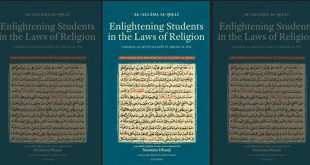This boos will address some of the key questions here include whether sacred law operates differently from secular law, why laws change or stay the same and how different cultural and historical settings impact the development of legal rulings.
Premodern Islamic law as formulated in the four Sunni legal traditions is sometimes described as the end product of the process of interpreting the foundational texts, namely the Qur’an and the hadith (sayings of the Prophet). Jurists are said to have attempted to derive the laws from these sources. This impression owes to the fact that a legal reason (i.e., the reason a jurist gives for a law) often takes the form of a specific interpretation of the Qur’an and hadiths, suggesting that the process of interpreting these sources is what generated the law. On this view, these texts represented the starting point of jurisprudence, and the laws its outcome. The transformation of the textual raw material into the laws is said to have taken place through the application of established, recognized methods of interpretation, methods that are described in the classical Islamic genre of legal theory, the usul al-fiqh.
The book shows that in fact, at least in the Hanafi case, this image must be turned on its head. What is thought to be the outcome of jurisprudence, namely the laws, are actually the starting point for the jurist. The end product, on the other hand, is an interpretation that reconciles the law with the textual “sources,” the Qur’an and the Prophet’s sayings. The role of the methods of interpretation, therefore, is not to generate the laws, but rather to reconcile them with the textual sources. The hermeneutic standards governing the process of interpretation can be seen to be so loose as to be inherently incapable of generating laws. They are so flexible that they can be used to reconcile just about any conceivable candidate for the law with the textual sources. Providing maximal indeterminacy, these standards do not constrain the jurist to adopt one possibility (as to what the legal outcome should be in a given matter) to the exclusion of another.
This pioneering study examines the process of reasoning in Islamic law. Some of the key questions addressed here include whether sacred law operates differently from secular law, why laws change or stay the same and how different cultural and historical settings impact the development of legal rulings. In order to explore these questions, the author examines the decisions of thirty jurists from the largest legal tradition in Islam: the Hanafi school of law. He traces their rulings on the question of women and communal prayer across a very broad period of time – from the eighth to the eighteenth century – to demonstrate how jurists interpreted the law and reconciled their decisions with the scripture and the sayings of the Prophet. The result is a fascinating overview of how Islamic law has evolved and the thinking behind individual rulings.
About the Author
Behnam Sadeghi has been an Assistant Professor of Religious Studies at Stanford University since 2006. His research spans Islamic thought and law in the early and post-formative periods.
Table of Contents
Key Technical Definitions
- A General Model
1.1.Revisability and Indeterminacy
1.2.A General Model of Decision Making and Exegesis
1.2.1.Motivation: The Islamic Case
1.2.2.A General Model of Decision Making and Exegesis
1.2.3.From an Individual to a Community
1.3.Exegetic Rationales and Degrees of Hermeneutic Flexibility
1.4.A Characterization of the Hanafis
1.4.1.Results
1.4.2.Previous Work in the Field
2.Preliminaries
2.1.The Hanafi School and the Case Studies
2.2.The Scholars
2.3.“Undesirable” as a Technical Term
3.Women Praying with Men: Adjacency
3.1.The Formative Background
3.2.Adjacency: The Two-Body Problem
3.2.1.Partitions and Gaps
3.3.Justification: “Keep Them Behind!”
3.4.The Multibody Problem and the Origin of the Adjacency Law
3.5.New Justifications
3.6.Adjacency: “Willing Out” Female Worshippers
3.7.Conclusion
Excursus: Women Leading Men
4.Women Praying with Women
4.1.The Formative Background
4.2.Formation of the Standard Position: Abu Hanifa to al-Marghinani
4.3.Justifying the Standard Position: Al-Marghinani to al-Babirti
4.4.The Maverick: Badr al-Din al-Ayani
4.4.1.Arguing from Tradition
4.4.2.The Isnads of the Traditions
4.4.3.Summing up al-‘Ayni
4.5.On the Fence: Ibn al-Huma
4.6.Later Hanafi Law
4.7.The Counterexample from Funeral Prayers
4.8.Two More Issues
4.8.1.Does Leadership Really Entail Improper Exposure?
4.8.2.Did the Abrogation Remove Permissibility?
4.9.Concluding Remarks
5.Women Praying with Men: Communal Prayers
5.1.Introduction
5.2.Early Hanafı Law: Abu Hanifa to al-Qudouri
5.2.1.The Two Eid Prayers
5.2.2.The Daily and Friday Prayers
5.2.3. After al-TAhawi
5.3. Al-‘Ayni
5.4. Ibn al-Humam’s Recipe for Legal Change
5.5.After Ibn al-Humam
6.The Historical Development of Hanafi Reasoning
6.1.The Forming Canon: Hanafi Beginnings
6.2.The Shifting Canon: The Rise of Hafith Folk Ideology
6.3.The Canon and Interpretation in Mature Hanafi Thought
7.From Laws to Values
7.1.Introduction
7.2.The Acceptability of Laws Birthed by Unacceptable Values
7.3.Justifications Need Not Reflect Motives
7.4.Jurists’ Reflections on Social Reality
7.5.The Jurist as Part of a Corporate Entity
7.6.From Laws to Society: What We Can Learn
7.7.Conclusion: Seeing Law as Law
Excursus: A Historian’s “Public Reason”
8.The Logic of Law Making
8.1.Introduction
8.2.Reasoning with Legal Principles
8.3.Formal Exegesis of the Canon
8.3.1.Exegetic Rationales and Hermeneutic Flexibility in Practice
Appendix: The Authenticity of Early Hanafi Texts: Two Books of al-Shaybani
Introduction
The corpora in the kitab al-Athar and their common features
The P-Corpus
The Q-Corpus
The relationship between P and Q
The Date of P and Q
Comparisons with al-Muwatta’
The Question of later Editing of rewriting
The traditions about Abu Hanifa and Ibrahim
The Traditions of Malik b. Anas
Conclusion
Postscript: later trajectories
Bibliography
Hanafi legal texts
Other premodern of early modern sources modern sources
Bibliographic Information
Title: The Logic of Law Making in Islam: Women and Prayer in the Legal Tradition
Author: Behnam Sadeghi
Publisher: Cambridge University Press
Language: English
Length: 242 pages
ISBN: 9780511920509
Pub. Date: February 11, 2013
 Ijtihad Network Being Wise and Faithful Muslim in the Contemporary World
Ijtihad Network Being Wise and Faithful Muslim in the Contemporary World
